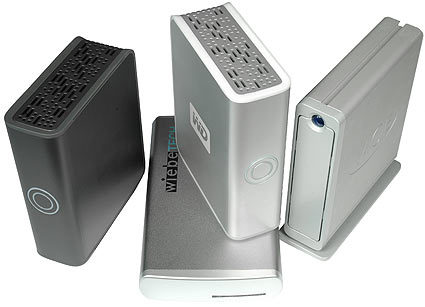500 GB External Drives Tested
From Hard Drives To Premium External Storage
The hard drive as we know it has changed. It is still a small box of iron casting with rotating platters inside, but it is no longer just the place where you install your operating system and some applications. The hard drive is shifting towards the center of our digital world, as it does not only store files, but is increasingly becoming a footprint of our lifestyle. Devices such as set top boxes, personal video recorders (PVRs), portable media players, home media centers, car entertainment and other digital-entertainment solutions increasingly rely on permanent storage. While it's hard to say where storage will be in 10 years - we might be storing our assets on networks rather than locally - it's safe to say that personal storage will be more important in the years to come.
External hard drives offer more flexibility, as the hard disk inside your PC is immobile and requires the computer to run whenever you want to access stored content from other devices. While this isn't an issue for the real enthusiast - her or his system runs 24/7 anyway - the average user typically doesn't want or need the system to run all the time. An external hard drive comes in handy, as you simply attach it to different PCs or notebooks using the interface of your choice.
Hard drives support USB 2.0, and the majority of PC systems offers several USB ports. However, USB 2.0 has been a bottleneck for modern hard drives, as it maxes out at slightly above 30 MB/s, which is roughly a third of the throughput you can expect from a new 7,200 RPM hard drive.
ESATA To The Rescue
Some external hard drives use Firewire interfaces, either IEEE 1394a at 400 Mb/s or 1394b, which supports up to 800 Mb/s gross bandwidth. This isochronous interface is important for anyone interested in video editing, as most DV camcorders that don't directly store digital files on 1.8" hard drives or DVDs will utilize Firewire to transfer video content to PCs. Firewire 1394b is clearly faster than 1394a or USB 2.0, but its limits are still well below the maximum throughput of modern hard drives. eSATA is coming to the rescue these days: A modification of the SATA standard, it allows for the deployment of individual hard drive products without a PC connection. As it fully complies with the SATA protocol - on which many hard drive controllers and hard drives are based - eSATA delivers the full bandwidth of 150 or 300 MB/s. In other words, this means that you can run an external hard drive product as fast as if it were installed internally.
Things first started with hard drive enclosures with USB 2.0 interfaces, for which you had to buy an UltraATA hard drive of your choice to install. The storage vendors quickly realized the potential of external storage; it doesn't come as a surprise that there are hundreds of products available today, utilizing all sorts of interfaces. External storage now comes in single or multiple hard drive flavors, with or without built-in redundancy features such as RAID. Although a single hard drive does not provide sufficient protection for highly-important data, it is sufficient for personal use. This is why the most popular external storage products are single-disk external hard drives.
Almost all drive manufacturers offer their own solutions, or you can find offerings from third-party vendors such as Freecom, Iomega, Plextor, Simpletech, Wiebetech and others. We received 500 GB mainstream drives from LaCie, Western Digital and Wiebetech, which we look at here.
Get Tom's Hardware's best news and in-depth reviews, straight to your inbox.
Current page: From Hard Drives To Premium External Storage
Next Page LaCie D2 Quadra
Patrick Schmid was the editor-in-chief for Tom's Hardware from 2005 to 2006. He wrote numerous articles on a wide range of hardware topics, including storage, CPUs, and system builds.
